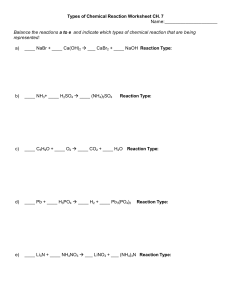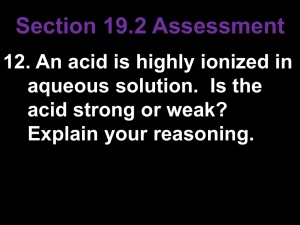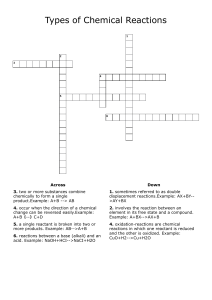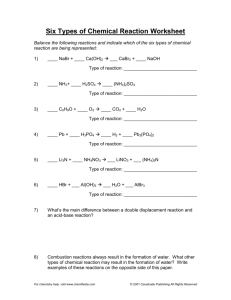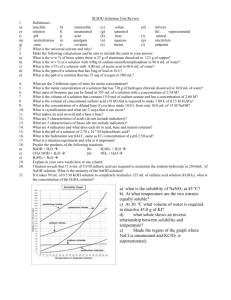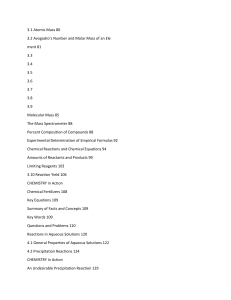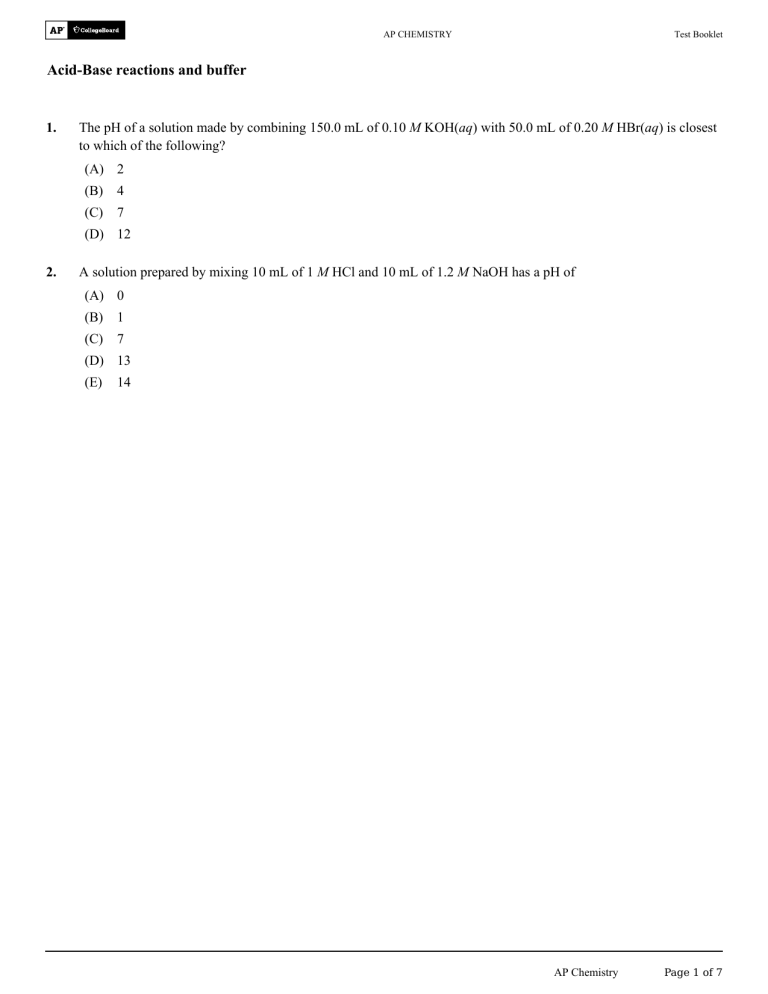
AP CHEMISTRY Test Booklet Acid-Base reactions and buffer 1. The pH of a solution made by combining 150.0 mL of 0.10 M KOH(aq) with 50.0 mL of 0.20 M HBr(aq) is closest to which of the following? (A) 2 (B) 4 (C) 7 (D) 12 2. A solution prepared by mixing 10 mL of 1 M HCl and 10 mL of 1.2 M NaOH has a pH of (A) 0 (B) 1 (C) 7 (D) 13 (E) 14 AP Chemistry Page 1 of 7 Test Booklet Acid-Base reactions and buffer 3. For parts of the free response question that require calculations, clearly show the method used and the steps involved in arriving at your answers. You must show your work to receive credit for your answer. Examples and equations may be included in your answers where appropriate. Methanoic acid, , ionizes according to the equation above. (a) Write the expression for the equilibrium constant, , for the reaction. Please respond on separate paper, following directions from your teacher. (b) Calculate the of a solution of . Please respond on separate paper, following directions from your teacher. (c) In the box below, complete the Lewis electron-dot diagram for valence electrons. . Show all bonding and nonbonding Please respond on separate paper, following directions from your teacher. Page 2 of 7 AP Chemistry Test Booklet Acid-Base reactions and buffer (d) In aqueous solution, the compound is combined with a reacts according to the equation above. A sample of . (i) Write the balanced net ionic equation for the reaction that occurs when . sample of is combined with Please respond on separate paper, following directions from your teacher. (ii) Is the resulting solution acidic, basic, or neutral? Justify your answer. Please respond on separate paper, following directions from your teacher. When a catalyst is added to a solution of occurs. , the reaction represented by the following equation (e) Is the reaction a redox reaction? Justify your answer. Please respond on separate paper, following directions from your teacher. AP Chemistry Page 3 of 7 Test Booklet Acid-Base reactions and buffer (f) The reaction occurs in a rigid vessel at , and the total pressure is monitored, as shown in the graph above. The vessel originally did not contain any gas. Calculate the number of moles of produced in the dissolved in the solution is negligible.) reaction. (Assume that the amount of Please respond on separate paper, following directions from your teacher. (g) After the reaction has proceeded for several minutes, does the amount of catalyst increase, decrease, or remain the same? Justify your answer. Please respond on separate paper, following directions from your teacher. Solution 4. Acid Ka ¯¯¯¯¯¯¯¯¯¯¯¯¯ ¯¯¯¯¯¯¯¯¯¯¯¯¯ ¯¯¯¯¯¯¯¯¯¯¯¯¯ 1 CH3CO2H 1.75 × 10-5 2 CF3CO2H 1.0 × 100 Acid-dissociation constants of two acids are listed in the table above. A 20. mL sample of a 0.10 M solution of each acid is titrated to the equivalence point with 20. mL of 0.10 M NaOH. Which of the following is a true statement about the pH of the solutions at the equivalence point? (A) Solution 1 has a higher pH at the equivalence point because CH3CO2H is the stronger acid. (B) Solution 1 has a higher pH at the equivalence point because CH3CO2H has the stronger conjugate base. (C) Solution 1 has a lower pH at the equivalence point because CH3CO2H is the stronger acid. (D) Solution 1 has a lower pH at the equivalence point because CH3CO2H has the stronger conjugate base. 5. of A student mixes ] of the resulting solution? with of at . What is the [ (A) (B) (C) (D) 6. A solution containing HCl and the weak acid HClO2 has a pH of 2.4. Enough KOH(aq) is added to the solution to increase the pH to 10.5. The amount of which of the following species increases as the KOH(aq) is added? Page 4 of 7 AP Chemistry Test Booklet Acid-Base reactions and buffer (A) Cl-(aq) (B) H+(aq) (C) ClO2 -(aq) (D) HClO2(aq) 7. A student learns that ionic compounds have significant covalent character when a cation has a polarizing effect on a large anion. As a result, the student hypothesizes that salts composed of small cations and large anions should have relatively low melting points. a. Select two compounds from the table and explain how the data support the student’s hypothesis. b. Identify a compound from the table that can be dissolved in water to produce a basic solution. Write the net ionic equation for the reaction that occurs to cause the solution to be basic. Please respond on separate paper, following directions from your teacher. 8. The net ionic equation for the reaction that occurs during the titration of nitrous acid with sodium hydroxide is (A) HNO2 + Na+ + OH– → NaNO2 + H2O (B) HNO2 + NaOH → Na+ + NO2– + H2O (C) H+ + OH– → H2O (D) HNO2 + H2O → NO2– + H3O+ (E) 9. HNO2 + OH– → NO2– + H2O Addition of sulfurous acid (a weak acid) to barium hydroxide (a strong base) results in the formation of a precipitate. The net ionic equation for this reaction is (A) 2 H+(aq) + 2 OH-(aq) ⇄ 2 H2O(l) (B) H2SO3(aq) + Ba2+(aq) + 2 OH-(aq) ⇄ BaSO3(s) + 2 H2O(l) (C) 2 H+(aq) + SO32-(aq) + Ba2+(aq) + 2 OH-(aq) ⇄ BaSO3(s) + 2 H2O(l) (D) H2SO3(aq) + Ba2+(aq) + 2 OH-(aq) ⇄ Ba2+(aq) + SO32-(aq) + 2 H2O(l) (E) H2SO3(aq) + Ba(OH)2(aq) ⇄ BaSO3(s) + 2 H2O(l) AP Chemistry Page 5 of 7 Test Booklet Acid-Base reactions and buffer 10. Nitrous acid reacts with ammonia according to the balanced chemical equation shown above. If of and of are mixed and allowed to reach equilibrium at what is the approximate at equilibrium? , (A) (B) (C) (D) 11. When 200. mL of 2.0 M NaOH(aq) is added to 500. mL of 1.0 M HCl(aq), the pH of the resulting mixture is closest to (A) 1.0 (B) 3.0 (C) 7.0 (D) 13.0 at 12. The equilibrium for the acid ionization of react with of of the resulting solution? correct (A) (B) (C) (D) Page 6 of 7 AP Chemistry is represented by the equation above. If of , which of the following could be used to calculate the Test Booklet Acid-Base reactions and buffer 13. A student prepares three solutions, X, Y, and Z, as described in the table above. The values of Ka for the acidic species in the solutions are given in the table below. a. Using the information above, write the letters of the solutions in the boxes below to rank the solutions in order of increasing pH. Explain your reasoning for the ranking. b. Does the pH of solution Y increase, decrease, or remain the same when 100 mL of water is added? Justify your answer. c. The student adds 0.0010 mol of NaOH(s) to solution Y, and adds 0.0010 mol of NaOH(s) to solution Z. Assume that the volume of each solution does not change when the NaOH(s) is added. The pH of solution Y changes much more than the pH of solution Z changes. Explain this observation. Please respond on separate paper, following directions from your teacher. 14. Which of the following species is the strongest base in the reaction represented above? (A) (B) (C) (D) AP Chemistry Page 7 of 7
